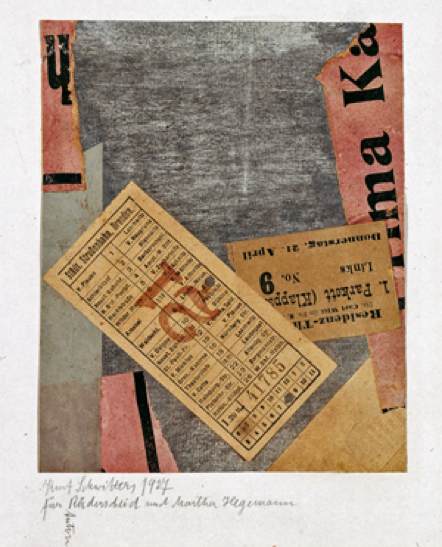Anton Räderscheidt
Kurt Schwitters
Painter of the New Objectivity
1927

For Anton Räderscheidt and Martha Hegemann 1927
Paper collage 15.9 x 12.9 cm, mounted by the artist on light cardboard 29.6 x 24.1 cm, framed under glass. Signed and dated Kurt Schwitters 1927 in pencil below the depiction on the backing and with a personal dedication for Anton Räderscheidt [her] and Martha Hegemann.
Orchard/Schulz 1515 with color ill. p. 282
Provenance: Martha Hegemann and Anton Räderscheidt, Cologne; Sydney Janis Gallery, New York (1959; with label on back of frame); Charlotte and Walter Bareiss, Zurich (until 1994; label on the back with inventory no. SL.69.17.40); Galerie Fred Jahn, Munich (until 1996; with label on the back); South German private ownership
Exhibition: New York 1959 (Sydney Janis Gallery), 75 collages by Kurt Schwitters, cat. no. 31 with ill.; Munich 1965 (Bavarian State Painting Collections, New State Gallery Munich), Walter Bareiss Collection, cat. p. 35; Kassel 1967 (State Art Collections Kassel), Walter Bareiss Collection, hand drawings, watercolors and collages, cat. with ill. p. 25.
The collage “for Anton Räderscheidt and Martha Hegemann” was created in the late 1920s using already used tickets for the Residenz Theater and for the tram in Hannover as well as advertising material.
Schwitters justifies his preference for old materials by saying that the material is not important. This is not only paradoxical, but also surprising given his true material obsession. On the other hand, it makes sense when you consider that in the end it was all about mastery of form. ‘The material’, he writes, is as insignificant as I am. The form is essential. Because the material is immaterial, I take whatever material the image calls for. By matching different types of materials against each other, I have an advantage over just oil painting, because in addition to color against color, line against line, form against form, etc., I also value material against material. I call the world view from which this kind of art creation became ‘Merz’. (Werner Schmalenbach, Kurt Schwitters, Munich 1984, p. 96). And as is so often the case, Schwitters also brilliantly fulfills the promise of the most intensive formal work in the present collage: it does not stand in any of the strict art of, for example, El Lissitzky, who was active in Hanover at the same time, or in the works of the early 1920s by the then Bauhaus master Laszlo Moholy -Nagy after; the precision with which the parts are assigned to each other and coordinated spatially is masterful.
Anton Räderscheidt and his wife, the painter Martha Hegemann, were known to Kurt Schwitters from the Dada context; Räderscheidt suddenly became known around 1925 as a progressive artist who was more interested in the unspoken behind things than their “new objective” representation; the dedication of this collage is an expression of the esteem in which the chief Dada artist held him and his wife.